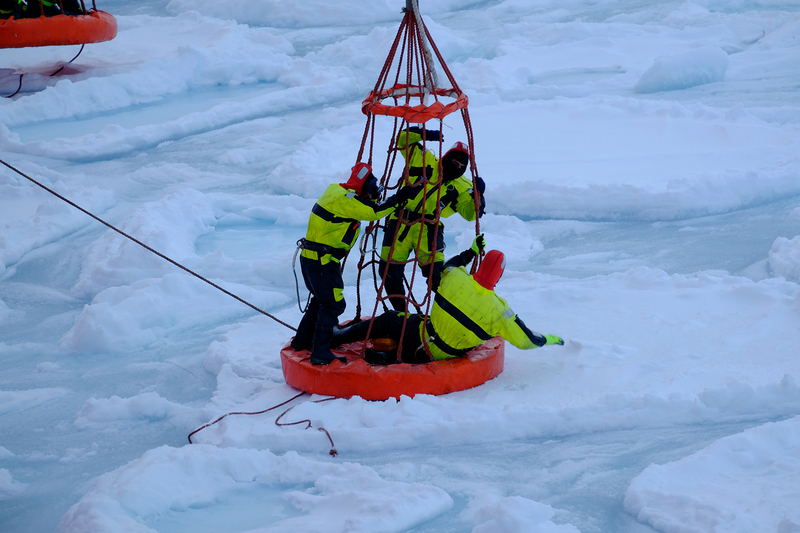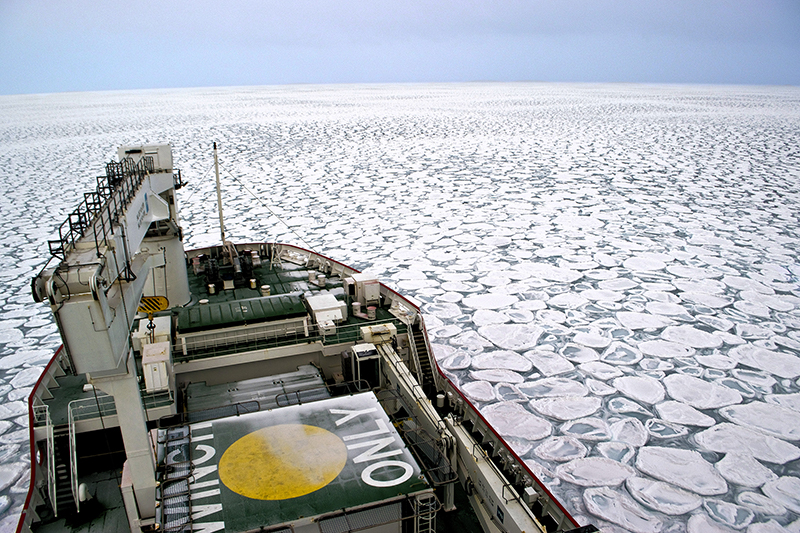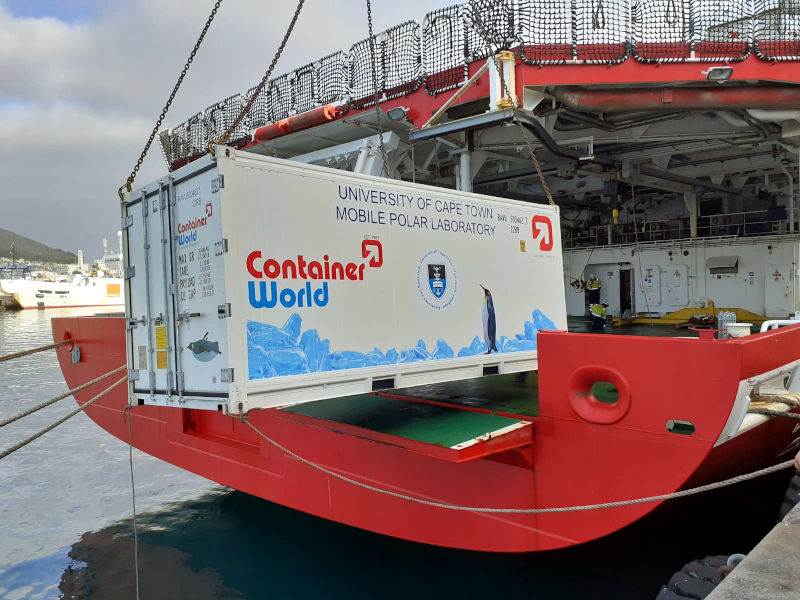Polar cyclones, Antarctic sea ice and a cruise to understand it all
15 July 2019 | Story Staff writer. Read time 10 min.
On Thursday, 18 July 2019, the South African research vessel SA Agulhas II departs from Cape Town bound for the Southern Ocean and Antarctica’s winter sea ice. Onboard will be 25 researchers from the University of Cape Town (UCT), joining 70 participants from South Africa and the rest of the world.
The expedition – which is part of a large collaborative project sponsored by the South African National Antarctic Project (Southern oCean seAsonaL Experiment, SCALE) – plans to study winter conditions in the Southern Ocean and Antarctica’s sea ice. Something scientists realised we knew very little about after they unexpectedly saw extreme changes to Antarctic sea ice during 2016.
In addition to Associate Professor Marcello Vichi from the UCT Department of Oceanography, the cruise’s chief scientist, there will be two principal investigators from oceanography – Dr Katye Altieri and Dr Sarah Fawcett – and three from the Faculty of Engineering & the Built Environment – Associate Professor Amit Mishra, Tokoloho Rampai and Associate Professor Sebastian Skatulla.
The team will also be the first to use a new mobile polar laboratory they’ve installed on the SA Agulhas II – a joint effort between UCT engineering and oceanography.
Mysterious melting
During 2016, the natural, seasonal melting of sea ice in Antarctica happened in less than a month between October and November – something that had never happened before. It usually takes three to four months to melt. During 2016, the extent of the ice also reached a record low.
As Vichi describes it, the 2016 melt “had an interesting statistical consequence: it wiped out the apparent increasing trend that has been reported for Southern Hemisphere sea ice previously.” A trend that had, up to then, been in stark contrast to the dramatically declining sea ice in the Arctic.
Vichi says that there are a few hypotheses on how or why this happened, but without better understanding, they won’t be able to predict how the Southern Ocean and its ice will respond to climate change.
“Winter cruises to the Antarctic are essential to bridge this gap in our knowledge.”
“In short, if we don’t know how sea ice responds to the seasonal cycle it is hard to project its behaviour into the future,” says Vichi.
Antarctic sea ice is usually measured throughout the year using satellites. However, the reliability of remote sensing relies on direct measurements taken by scientists on the ice – and only very few of those measurements have been taken during winter.
“Winter cruises to the Antarctic are essential to bridge this gap in our knowledge,” continues Vichi. “South Africa – and UCT – have contributed considerably to collecting more winter data over the past few years.”
Polar cyclones
During a previous, recent cruise to Antarctica, Vichi and his colleagues had the opportunity to measure – for the first time – the impact of an unusual and intense storm on the sea ice there. They saw first-hand the effects of an explosive polar cyclone as it passed over the marginal ice zone: the section of sea ice close to the open ocean where atmospheric, oceanic and ice processes are closely interlinked.

The cyclone they observed was ‘explosive’ because of the sudden, intense deepening of low pressure at its centre.
What they saw provided the first direct evidence of a winter polar cyclone rearranging the marginal ice zone. The storm altered ice distribution – by increasing waves and the drift of floes, for example – and these effects extended as far as the Antarctic continent.
After analysing more storms in the region, the team were able to confirm how storms in the Southern Ocean maintain sea ice that is less compact and more mobile than previously understood.
This is something they intend to explore further as part of the upcoming expedition.
A multi-disciplinary approach to sea ice
Ahead of this cruise, UCT’s engineering and oceanography departments joined forces to equip and install the first mobile polar laboratory on the SA Agulhas II.
Using the new laboratory, the cruise’s research team will be able to analyse sea-ice cores in the field and learn about the physics, biology and chemistry of this ephemeral habitat that exists for only a short time each year. They will be able to measure crucial mechanical properties of sea ice to inform models of sea-ice dynamics under different atmospheric and oceanic conditions.

While Dr Sarah Fawcett’s team will characterise the biogeochemical content of the ice to understand its role as a buffer for nutrients and life, Dr Altieri and her team will look at the chemistry of the polar atmosphere and how it is affected by exchanges of chemicals and energy between the air and sea.
The data they collect will be complemented by automatic and direct observations of the sea ice. To do this, they’re using dedicated sea-ice cameras developed jointly with partners from the universities of Melbourne and Adelaide, Australia.
Through this work, UCT researchers will help the South African Weather Service to improve their detection of sea ice for navigation and ice charting.
A team of UCT engineers led by Mishra and Dr Robin Verrinder have prototyped a set of inexpensive ice-tethered buoys to explore the impact of polar cyclones as they cross the marginal ice zone. The buoys are designed to communicate with each other once deployed, and ultimately, with the scientists via satellite. They will test them during the cruise.
“Lots of exciting new science is expected from this project. It will provide the first coverage of an entire seasonal cycle of sea ice in the Atlantic sector of the Southern Ocean.”
“Instrument building is one of the directions that UCT has decided to foster and expand, as – understandably – polar sciences have not been much developed in Africa and specialised instruments are very expensive,” says Vichi.
More to come
This winter cruise of the SA Agulhas II is just one component of the extended SCALE programme. Later this year, during October and November, there will be a similar spring-time expedition to cover the period when Antarctic sea ice is melting more quickly.
“Lots of exciting new science is expected from this project. It will provide the first coverage of an entire seasonal cycle of sea ice in the Atlantic sector of the Southern Ocean,” says Vichi.
The cruise is a collaboration between several South African institutions (the Cape Peninsula University of Technology, the Council for Scientific and Industrial Research, South African Weather Service, Stellenbosch University, the University of Pretoria and the University of Cape Town) and international partners in Australia, France, Germany, Sweden and the United Kingdom.
During August, after the SA Agulhas II returns to East London, the vessel will be open for two days (on 9 and 10 August) for schools and the public. This is an opportunity for people to see in-person how sea ice is measured and engage with scientists and students.
- Vichi M et al. (2019) Effects of an Explosive Polar Cyclone Crossing the Antarctic Marginal Ice Zone.Geophysical Research Letter. doi.org/10.1029/2019GL082457
Correction: An earlier version of this story misstated the day of the expedition’s departure. It has been corrected.
 This work is licensed under a Creative Commons Attribution-NoDerivatives 4.0 International License.
This work is licensed under a Creative Commons Attribution-NoDerivatives 4.0 International License.
Please view the republishing articles page for more information.










